Noah Katterbach has just over a year left on his contract at FC Koln. Whether or not he intends to sign an extension (and for the sake of his continued development I think he should), there will undoubtedly be many teams from the Bundesliga and afar monitoring this situation. For the 2019/20 season has been a breakout one for the young German left-back, as he has gatecrashed Köln’s starting XI under Markus Gisdol, providing solid, if unspectacular, defensive performances, but where he is truly exciting is with the ball at his feet.
One of the most intriguing things about Katterbach is he is still a very raw talent. Watch any Katterbach performance this season and you will see flashes of brilliance, accompanied by some questionable decision-making to be expected of a 19-year-old in his first season of senior football. It is this very rawness which in my opinion makes it such an important decision for him to stay at Köln for the meantime where he will continue to get game time and develop out of the spotlight. However, were a team higher up the table to swoop in for him, looking for a cut-price deal for a clearly promising talent, it certainly wouldn’t be the first time, and it won’t be the last.
Throughout this scout report and tactical analysis, I will highlight his strengths and weaknesses, assessing Katterbach alongside the Bundesliga’s other left-backs, as well as the exciting talent in the same position, scattered across Europe’s Top Five leagues.
Overview
Köln’s tactics have led to them predominantly using a 4-2-3-1 or a 4-4-2 this season, but regardless of their formation they will opt for a back four, and when Katterbach operates as left-back he will do so with a winger in front of him.
Although an exciting attacking talent, Katterbach operates relatively deep compared to what we might expect to see from a modern-day attacking full-back, as the heat map below shows, which is perhaps down to Gisdol’s preferences more than anything.
A lot of Katterbach’s work on the ball can be seen from inside his own half, as I will go onto highlight later.
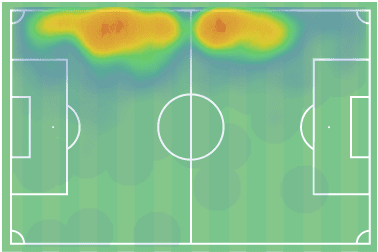
Dribbling and offensive duels
When comparing Katterbach to the rest of the Bundesliga’s left-backs, as well as Europe’s best U21 left-backs I am only including those who have played at least 450 minutes at left-back this season.
The first part of Katterbach’s game I’d like to give an analysis of is his on-ball ability. Katterbach is very confident and calm in possession, and is excellent when taking on an opponent in a one v one situation.
We can see when measuring him with the best U21 left-backs in Europe, only Japhet Tanganga has a better completion percentage, however, Katterbach attempts far more than the Tottenham youngster. It will be interesting to see this part of Katterbach’s game develop, and whether he can keep his completion percentage above the average if he attempts more dribbles per game, perhaps getting closer to the amount attempted by Alphonso Davies.
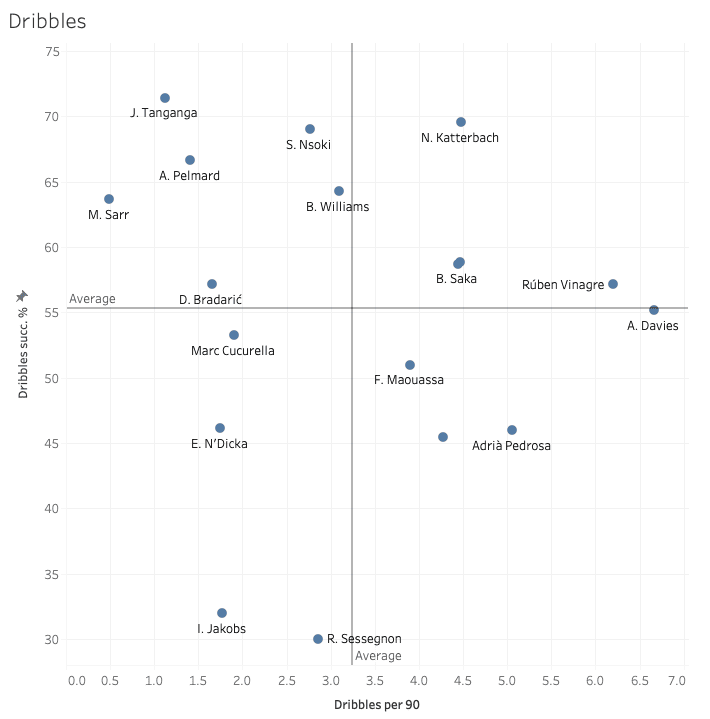
It is more impressive when we compare Katterbach to the rest of his league, where even among far more experienced left-backs Katterbach registers phenomenal figures.
Again Katterbach is one of the standouts for these metrics.
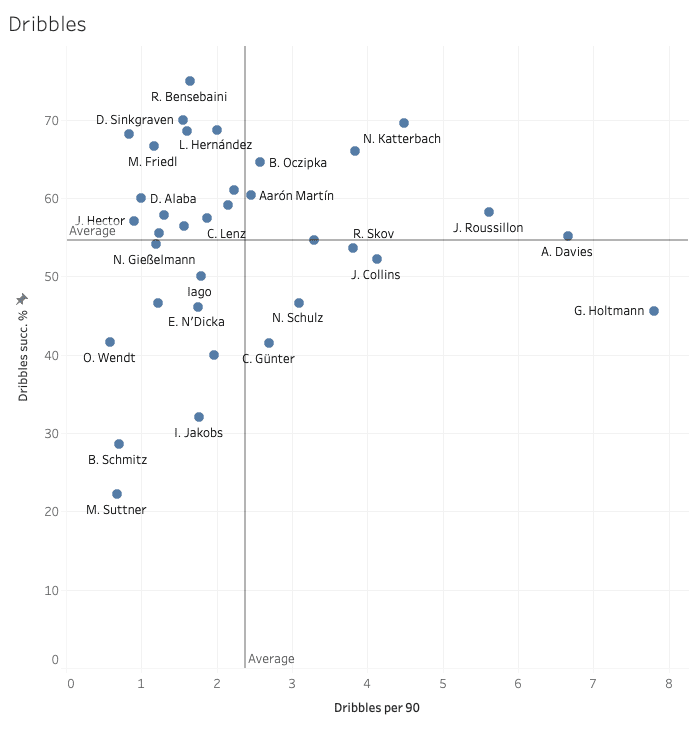
If we look at examples of Katterbach’s dribbling he favours taking on opponents who are putting him under pressure, rather than necessarily running at them and looking to attack space in behind. He is comfortable dribbling in tight spaces and looks to cut either side of the defender as they commit to a tackle. There appears to be a tendency in his dribbling to cut inside which is interesting as I believe his right-foot isn’t close to the quality of his favoured left. Nevertheless, he appears to be very successful with this tactic, perhaps with defenders expecting him to always play on his left side.
His one assist this season against Saarbrücken came from exactly this, cutting inside before laying a pass for Jonas Hector to score..
He demonstrates his calmness in possession with unwavering composure when under pressure, and will happily take on defenders even when camped far inside his own half under considerable pressure. We can see an example of this below against Wolfsburg as he shapes to play the ball long down the line, but instead cuts inside. This is risky but shows how confident he is in his own ability, his calmness on the ball, as well as his dribbling ability.
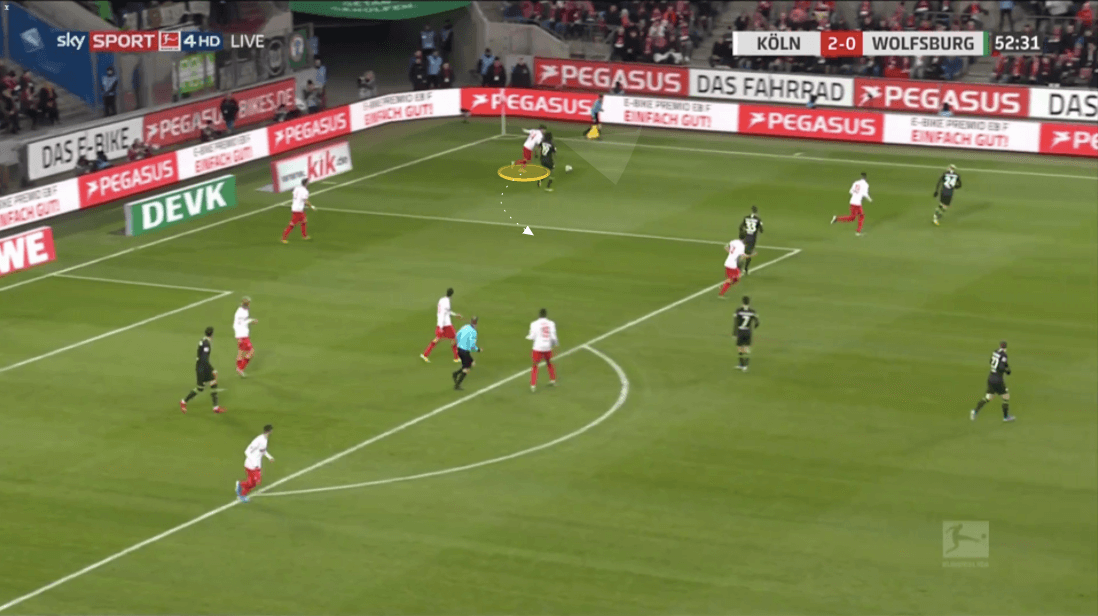
Naturally, there are times where this doesn’t come off, and specifically, when cutting inside he can turn into traffic, which is less than ideal when choosing to do so inside his own half.
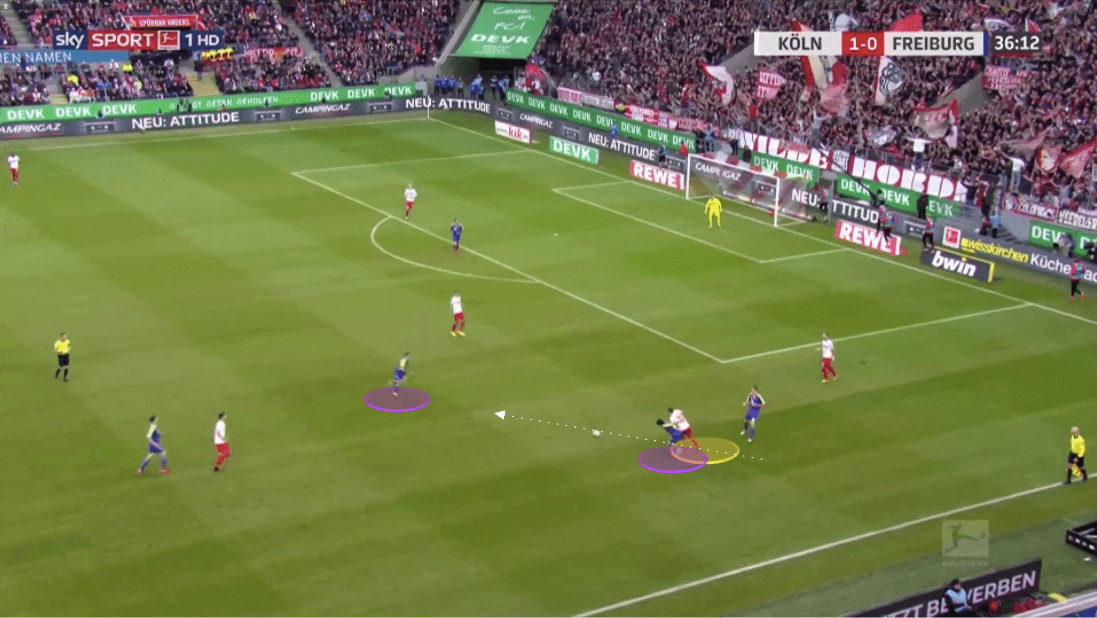
Passing and crossing
As much as Katterbach is an outlier when it comes to dribbles, there is seemingly work to be done with his passing.
If we look at the two graphs below, firstly comparing him to Europe’s U21’s and then to the Bundesliga’s left-backs, we can see that Katterbach’s passing accuracy certainly leaves a lot to be desired, however, his average pass length is longer than anyone else’s.
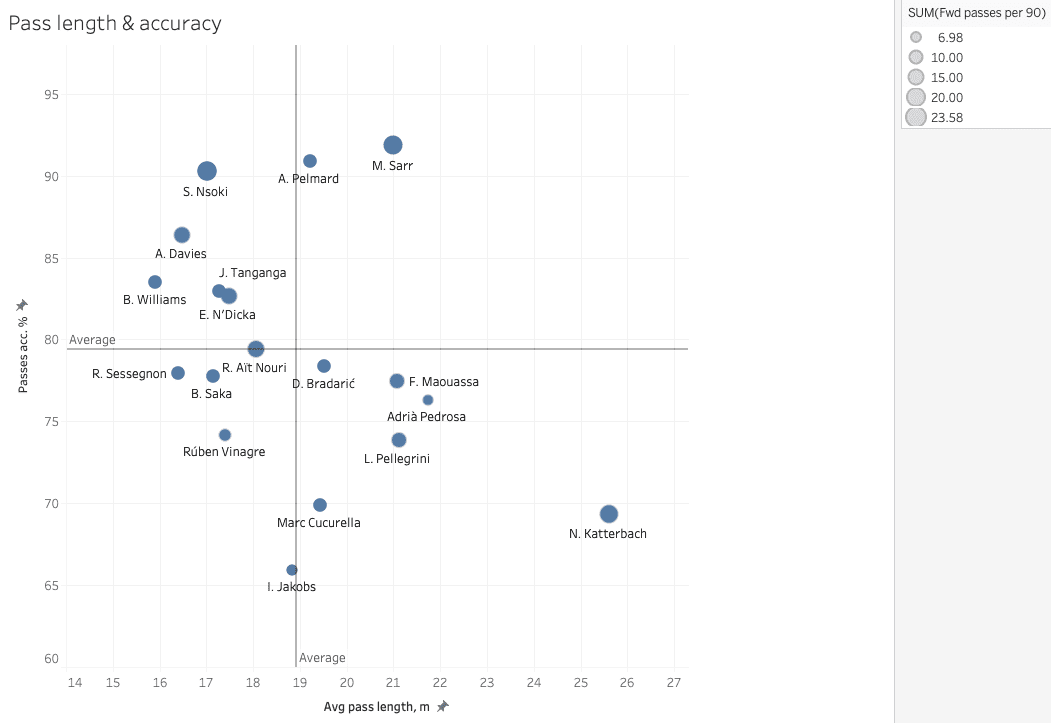
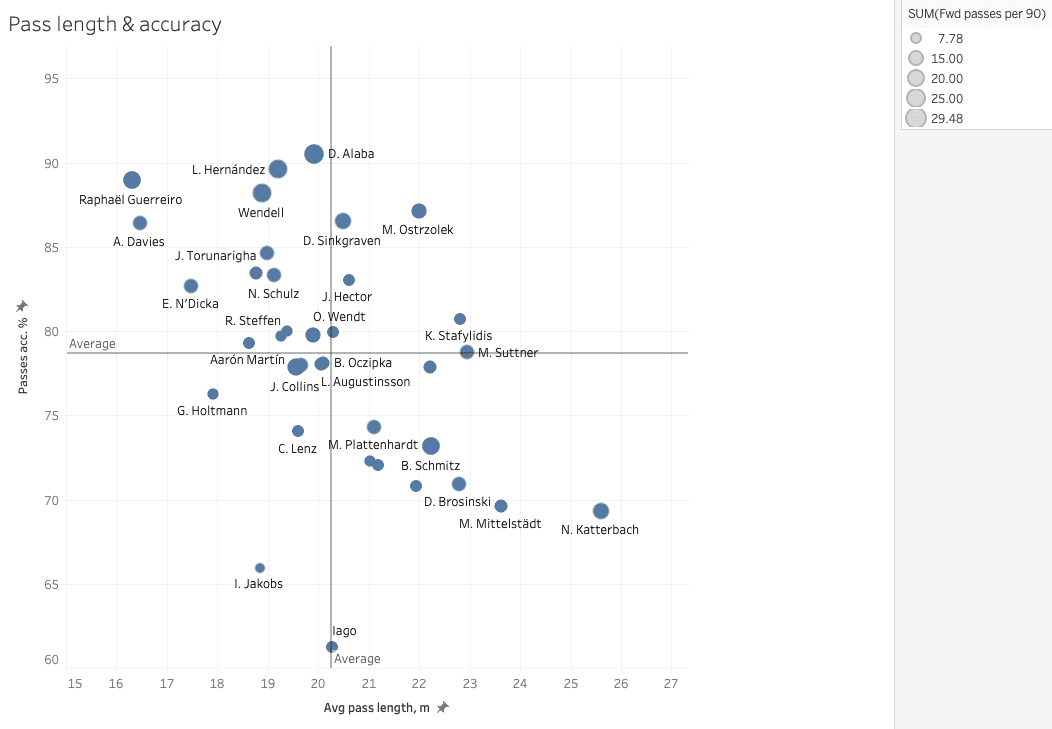
This may very well be down to the tactics used by Gisdol, and we can see in the same graphs that Katterbach is playing plenty of his passes forward, which is a good thing. However, mixed with his long pass length, this would go a long way to explaining his poor pass completion percentage.
Despite his dribbling ability when under pressure, Katterbach isn’t a roaming full-back looking to knock the ball past defenders, like Alphonso Davies for example, although Katterbach possesses relatively good pace albeit nothing like his Bayern Munich counterpart.
When in possession either just inside the opposition half or at least close to it he’s very consistent in his passing decisions. He looks to play forward, as the graphs above testify, and will, therefore, look inside for an attacking midfielder, down the line for his winger, and if there’s space behind the opposition defence he will look for the ball over the top. Along with his tendency to cut inside with his dribbling, we will often see him cut inside and look for the pass into the “10” space.
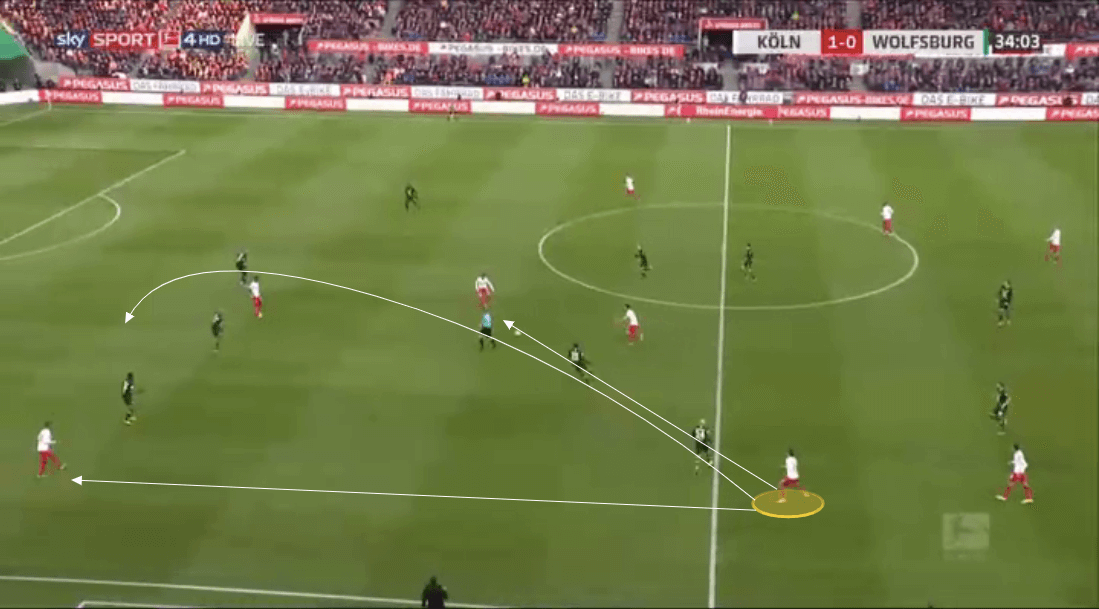
If there’s less space behind the defensive line, maybe due to being in a more advanced position himself, then he will instead look for the ball into the feet of his centre-forward and it’s common to see him take on this option regardless of pressure or players possibly blocking this option, trusting his pass.
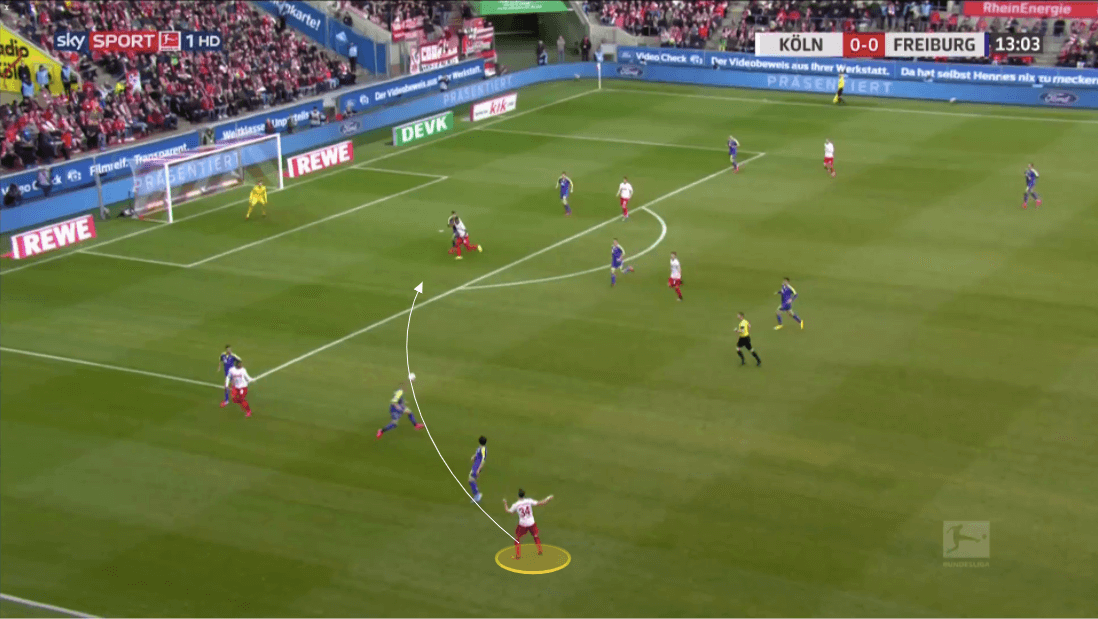
As good as he is with these kinds of passes, it would be good to see him develop his attacking intent. The image below shows his two decision from this area. It’s rare to see Katterbach instead choose to drive forward into the space in front of him, where he could seek to draw defenders out of the backline, and with his dribbling ability he should be more than capable of being a danger to opponents in these instances.
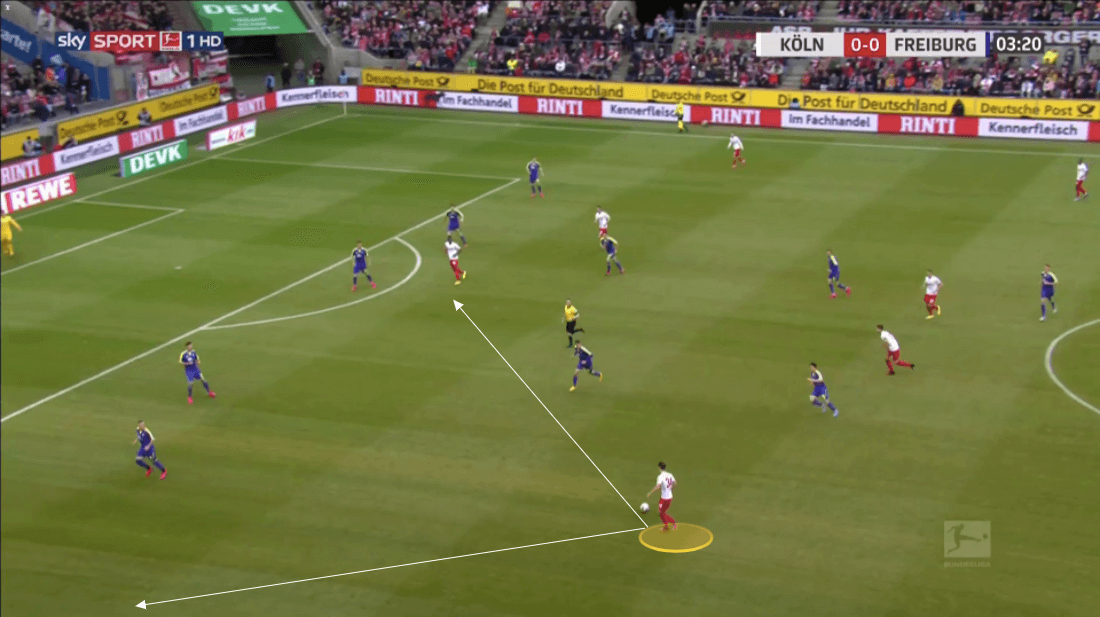
As we’ve covered already, Katterbach is comfortable in possession when under pressure, yet has shown at times a little too much comfort in these situations and has made lazy decisions in possession. Despite an easier option down the line in the image below, he decides to cut back on himself and play the pass to no one inside. This is just one example but is representative of where sometimes his composure can play himself or his teammates into trouble, just like the earlier example where he cut inside into traffic.
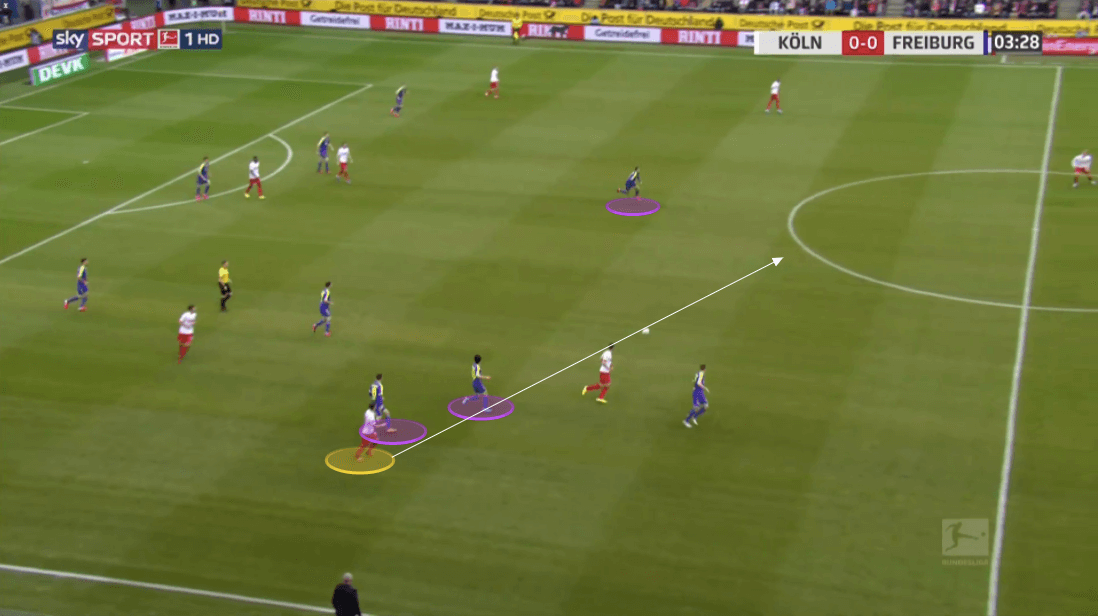
His crossing statistics make for even less impressive reading. In short, Katterbach doesn’t put a lot of crosses in, and the ones he does, he isn’t particularly accurate with.
Of course crossing isn’t the be all and end all by any means when it comes to measuring a full-back’s attacking contributions, however, by looking at the size of the plots on each graph we are able to see that Katterbach isn’t contributing too much in terms of directly impacting goal-scoring opportunities, with his xA per 90 pretty low too. There are other players on both graphs who perhaps aren’t elite crossers by any stretch yet are still contributing in other ways clearly, or are putting in particularly devastating crosses when they do.
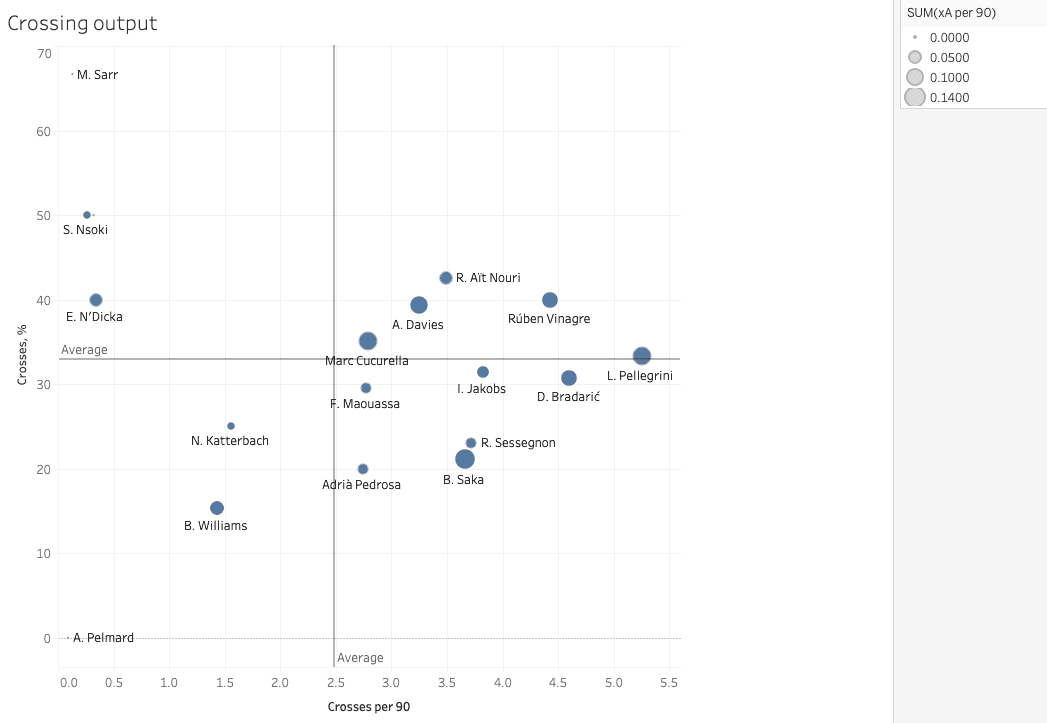
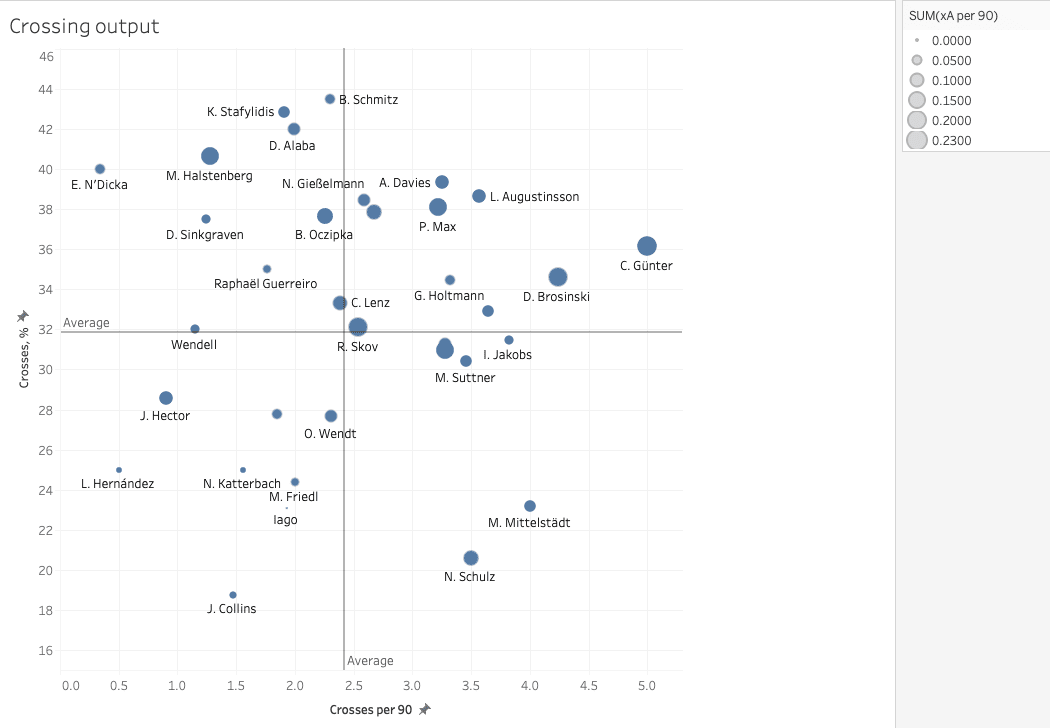
I believe Katterbach is a little bit laissez-faire in his approach to his crossing, and I don’t believe he values possession enough in these situations. Due to his more restrained approach with his attacking positioning, Katterbach doesn’t put many crosses on quick breaks where there are fewer defenders in the box, or perhaps the defence aren’t set, and therefore there is more space to hit crosses into.
The majority of his crosses come in situations where the defence is set and they have numbers back, greatly reducing the likelihood of a goalscoring chance coming from a cross.
There have been plenty of times this season where Katterbach has just decided to hit an aimless cross into the box and hope for the best. This approach can, of course, come off, but is hardly a way to conceive high-percentage scoring opportunities on a consistent basis, and his xA per 90 along with his crossing statistics will back this up.
His taste for cutting inside onto his right foot can lead to him putting in a fair few crosses with his weaker foot, which doesn’t lead high-quality crosses either. The image below shows him cutting inside and using his right foot to swing the ball into an area where two Köln attackers are covered by four Borussia Dortmund defenders.
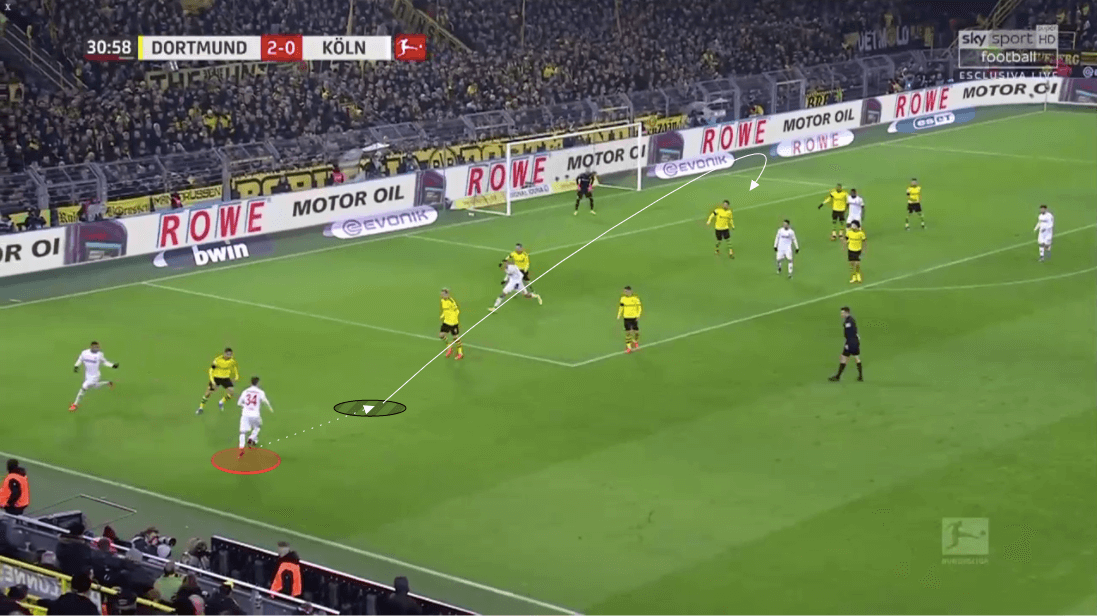
Defensive work
I mentioned right at the beginning that Katterbach has put up solid numbers when it comes to defensive duels.
Aerially he is involved in a fair amount of aerial duels, and has a respectable win percentage to go with that, winning 46.2% of his 3.44 aerial duels per 90. The same can be said of his overall defensive duels statistics which follow a very similar pattern. This season he has won 62.8% of his 6.88 defensive duels per 90, which is excellent.
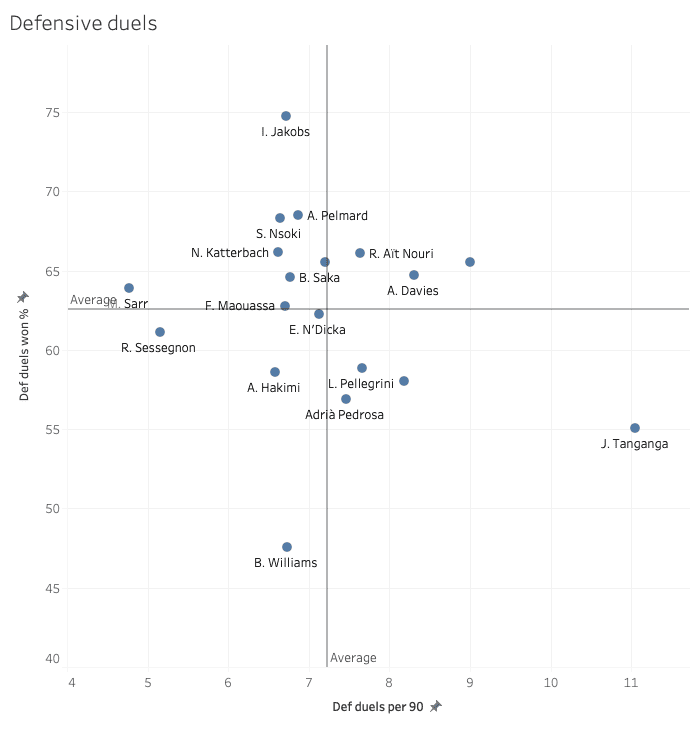
We can see that this ranks him in the upper-echelons when compared with the U21 left-backs in Europe’s top five leagues.
He holds his own domestically against all of the league’s left-backs, regardless of age too, and although he is involved in a lower than average amount of defensive duels, his win percentage shows he can be relied on to contribute in this department to the back four.
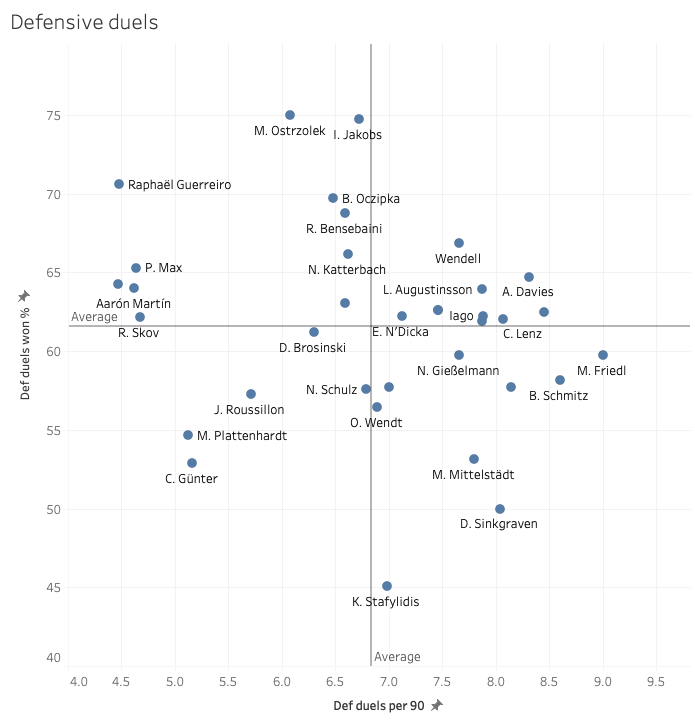
His positioning is where I believe there is the most room for development, however. Katterbach is slow to react at times, and this can lead to potential openings for the opponent.
Below we see a prime example of this as Köln centre-back, Sebastiaan Bornauw move forward to engage the Bayern forward Robert Lewandowski. One of the basic defensive principles within a back four, is when one player comes forward out of the four, the defence should move into tight back three behind the player who has moved forward. In the example below, Katterbach fails to recognise this and doesn’t drop back. His positioning leaves an open passing lane which Lewandowski exploits.
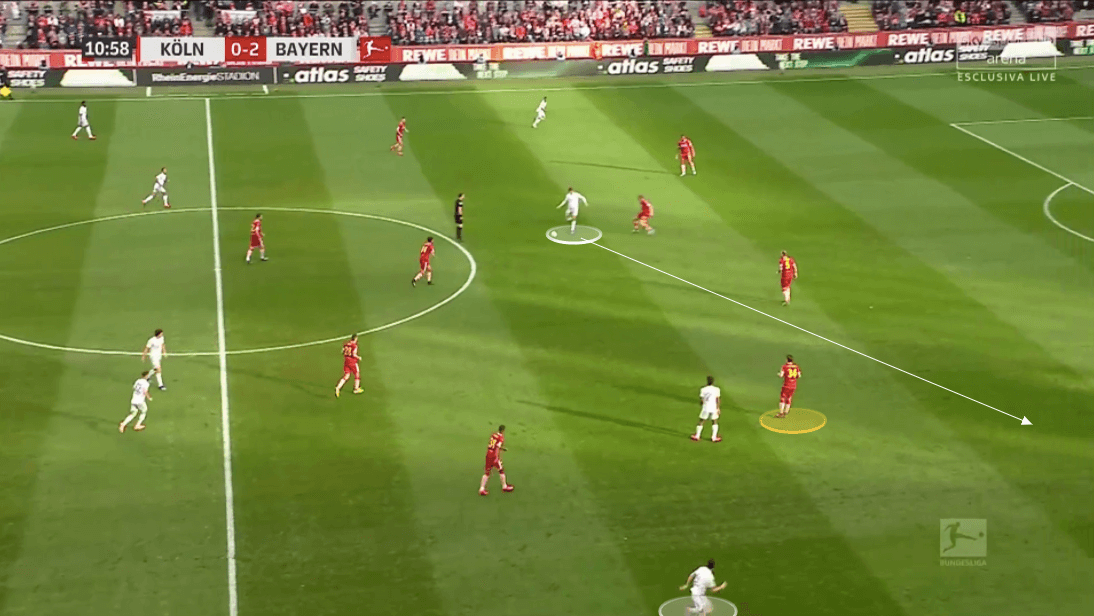
There seems to be a general laziness when tracking back which is another example of less than desirable defensive positioning. It’s either laziness or a lack of foresight, but there have been too many occasions this season where Katterbach doesn’t get back into position quick enough and this has led to goals scored against Köln. The example below shows him failing to read that his centre-back is moving further inside and therefore him getting closer to The Freiburg forward making a run into the back is of paramount importance. In this example, he failed to get there quick enough and Freiburg scored.
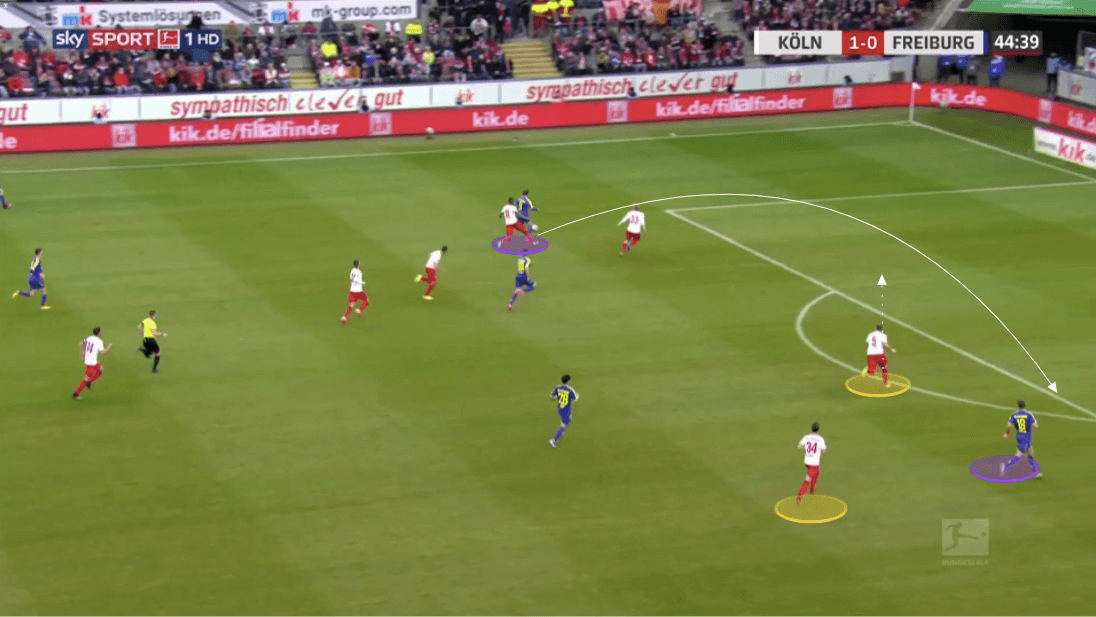
Again below we see him jogging back despite a dangerous Dortmund attack in an advanced area. As Bornauw dives in to make the tackle, momentarily dispossessing his opponent, it still leaves two Dortmund forwards around the ball, whilst Bornauw is still on the ground. Had Katterbach been sprinting to get back into position, there is every chance he would have been there to support Bornauw’s tackle and he could have stopped the Dortmund attack there and then.
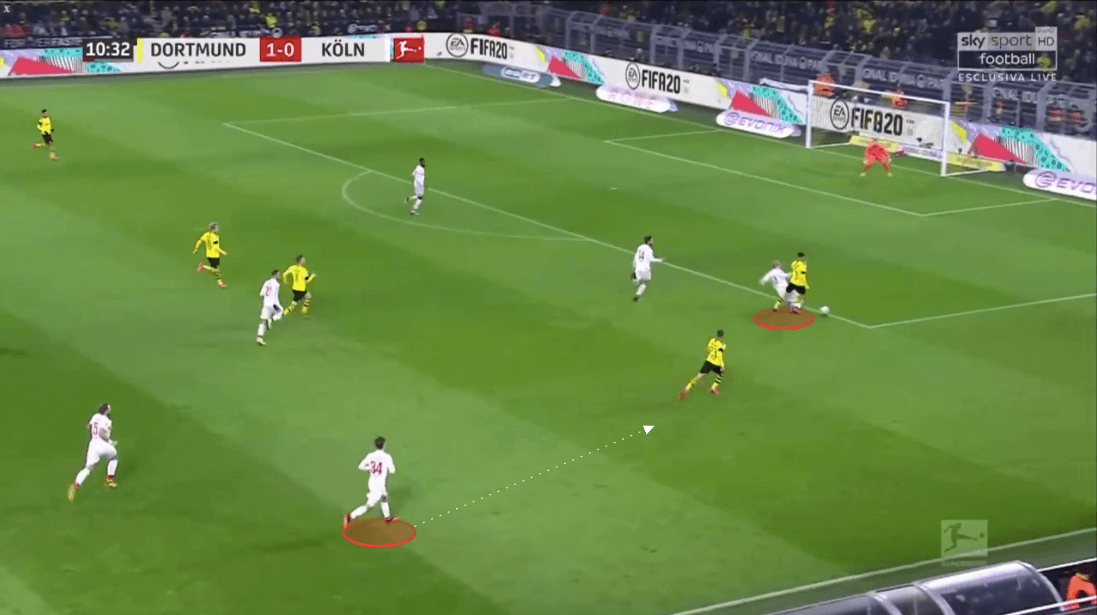
Conclusion
Katterbach is an exciting prospect and has shown enough in his appearances for the Köln first XI this season to suggest he could well be one to watch over the coming years, and it wouldn’t be surprising to see him in the national side in the future. Yet there is still a long way to go, and he can cement his starting place in the Köln side next season, which will, of course, aid his development significantly. Despite his excellent dribbling ability, there are still areas to improve with regards to his passing, crossing and overall attacking contribution, as well as his defensive positioning. Choosing to sign a contract extension and committing to Köln for the foreseeable future would be in his best interests to ensure he continues to get first-team football. Europe’s elite can wait.





Comments